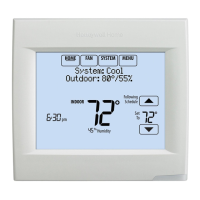
Do you have a question about the Honeywell Home TH8110R1008 and is the answer not in the manual?
| Compatibility | Heating and Cooling systems |
|---|---|
| Wi-Fi Connectivity | No |
| Programmability | 7-Day programmable |
| Backlight | Yes |
| Hold Function | Yes |
| Battery Backup | Yes |
| Voltage | 24VAC |
Describes the thermostat's application and lists its main features, including RedLINK compatibility and sensor options.
Details electrical ratings, RedLINK communication, temperature ranges, sensor accuracy, and mounting.
Explains system status indications and physical mounting requirements for the thermostat.
Covers essential guidelines, password retrieval, and initial wiring steps for thermostat installation.
Details how to locate the thermostat password required for installer options and setup.
Explains wiring options and compares VisionPRO® 8000 models based on stages and features.
Provides installation guidelines for RedLINK devices and steps for installing the Equipment Interface Module (EIM).
Details wiring the 24 Vac common and connecting discharge/return air sensors.
Guides on selecting proper mounting locations for discharge and return air temperature sensors in ductwork.
Provides guidance on choosing an optimal location for thermostat installation to ensure accurate readings.
Step-by-step instructions for installing the wallplate, connecting power via batteries or C-wire.
Provides wiring instructions for connecting the thermostat directly to heating/cooling equipment.
Instructions for installing batteries in optional accessories like outdoor sensors and portable comfort controls.
Outlines the steps for performing the initial setup, including system type and accessory configuration.
Guides the process of connecting the thermostat to the EIM or wireless adapter, confirming the link.
Explains how to connect RedLINK accessories to the thermostat by pressing the connect button.
Details finishing the setup process by selecting desired options and confirming completion on the thermostat.
Provides steps to add RedLINK accessories after the initial thermostat setup is complete, via Wireless Manager.
Identifies the location of the connect buttons on various RedLINK accessories for the linking process.
Lists and explains error codes that may appear during operation or setup, guiding troubleshooting steps.
Details connecting the RedLINK Internet Gateway and TrueSTEAM wireless adapter for proper operation.
Instructions for installing batteries and connecting wireless indoor sensors and remotes for control.
Details how to locate the thermostat password required for installer options and setup.
Lists available options within the Installer Options menu, such as Installer Setup and Wireless Manager.
Guides on using a microSD card to save setup time and make changes to installer setup options.
Introduces the Installer Setup table, detailing ISU numbers, names, settings, and defaults for configuration.
Details ISUs for heating system type, equipment, and radiant stage settings for proper configuration.
Covers settings for radiant stage 1 and 2, defining their availability and wiring requirements.
Details ISUs for configuring cool stages, compressor stages, and heat stages/backup heat stages.
Explains configuration for Cool Stage 3/4 and Heat Stage, including terminal requirements and availability.
Covers ISUs for Cool Stage 4, backup heat type, backup heat stages, and fan control in heat mode.
Configures economizer fault detection and wiring options for economizer control with or without an EIM.
Covers ISUs for running backup heat, backup heat type, and economizer fault/wiring settings.
Explains economizer fault detection and wiring options for economizer control with or without an EIM.
Details the functions of the A-L/A terminal for Time of Day, Economizer, and Heat Pump Fault alerts.
Configures system changeover between manual and automatic modes for heating and cooling control.
Sets the deadband for auto changeover, defining the separation between heat and cool setpoints.
Allows selection of Basic or Advanced control options for temperature regulation and stage control.
Configures differential settings for cool stages 2, 3, and 4 to manage temperature control and stage activation.
Sets the differential for radiant heat stage 2, impacting heating control based on temperature drops.
Configures differential settings for heat stages 2 and 3, influencing heating stage activation based on temperature.
Sets the differential for compressor heat stage 1, affecting geothermal radiant heat control.
Sets the differential for compressor heat stage 2, affecting heat pump and geothermal radiant heat control.
Configures backup heat droop for stages 1 and 2, and the upstage timer for backup heat activation.
Sets cycle rates per hour for heat stages and radiant stages to manage system cycling and efficiency.
Configures lockout setpoints based on outdoor temperature for heat pump and backup heat operation.
Sets cooling cycle rates per hour for stages 1 through 4, impacting compressor cycling and efficiency.
Configures heat cycle rates per hour for stages 1 through 3, defining system cycling for various heating types.
Sets backup heat cycle rates per hour for stages 1 and 2, impacting backup heating system cycling.
Configures compressor minimum off time and extended fan run time for cooling and heating efficiency.
Sets scheduled periods per day and configures pre-occupancy purge for commercial comfort.
Configures standard or occupancy-initiated overrides and sets the duration for temporary schedule changes.
Sets minimum and maximum heat recovery ramp rates and associated outdoor temperatures for efficient heating.
Sets outdoor temperature thresholds for minimum and maximum heat recovery ramp rates, optimizing energy use.
Configures the minimum cool recovery ramp rate and associated outdoor temperature for efficient cooling.
Sets the maximum cool recovery ramp rate and associated outdoor temperature for efficient cooling.
Sets the maximum cool recovery ramp rate and associated outdoor temperature for efficient cooling.
Configures adaptive recovery for efficient heating/cooling and keypad lockout for security.
Sets minimum cool and maximum heat setpoints, and configures remote entry/exit remote settings.
Configures setpoints for residential and commercial entry/exit remotes for various modes like Home, Away, Vacation.
Covers configuration for wired sensors like indoor, outdoor, return, and discharge sensors.
Configures indoor and outdoor sensors, including naming, type (10K/20K), and temperature control usage.
Configures return and discharge sensors, including type (10K/20K) and connection terminals.
Details connecting dry contact devices to S terminals for alerts like drain pan, filter, water leak, and shutdown.
Allows setting custom alerts for dry contact devices, specifying names and messages for notifications.
Sets up remote setback using occupancy sensors, including terminal connections and open/closed contact options.
Configures economizer fault detection and wiring options for economizer control with or without an EIM.
Configures alerts for drain pan status and dirty filters, including contact type and terminal connections.
Sets up alerts for water leaks and system shutdowns, specifying contact type and terminal connections.
Configures alerts for service needed and fan failure, specifying contact type and terminal connections.
Allows setup of custom alerts and filter reminders for system maintenance and performance.
Enables setting custom alert names and messages for dry contact device notifications.
Configures filter type (media/electronic cleaner) and the number of filters installed for reminders.
Sets reminders for air filter, electronic air cleaner cell, and post-filter replacement.
Configures humidifier type (steam, bypass, fan-powered) and wiring for humidification control.
Configures when the humidifier runs in heat, cool, or off modes, and the fan control method.
Sets reminders for humidifier pad replacement based on runtime days or calendar months.
Selects the sensor for dehumidification and configures dehumidifier wiring options (U terminals).
Sets the overcooling limit for dehumidification using the AC system, affecting temperature settings.
Configures minimum compressor run time and cooling droop for effective humidity reduction.
Sets whether the dehumidifier operates in heat, cool, or off modes, and configures fan control.
Configures ventilation types (ERV/HRV, Passive, Fresh Air) and control methods (ASHRAE, Percent On Time).
Sets the number of bedrooms, used for ASHRAE ventilation calculations in residential applications.
Configures ventilation rate (CFM) and priority (Lockouts vs. ASHRAE) for ventilation control.
Sets lockouts for ventilation based on outdoor temperature and dewpoint to maintain indoor air quality.
Configures ventilation lockouts during humidity control calls to maintain desired humidity levels.
Sets reminders for ventilator core and filter cleaning to ensure optimal system performance.
Configures backlighting behavior (On Demand/Continuous) and clock format (12/24 hour).
Manages daylight saving time settings and allows for indoor temperature and humidity offsets.
Guides on how to access installer tests via the MENU, Installer Options, and password entry.
Details how to test equipment and verify wireless communication strength between devices.
Describes how to perform the wireless test and interpret signal strength results for reliable communication.
Provides instructions for mounting wireless and wired outdoor sensors in optimal locations for accurate readings.
Step-by-step instructions for mounting the wireless indoor sensor, including wallplate attachment.
Details the process of mounting a wired indoor sensor, including wire routing and wallplate attachment.
Provides a quick reference to the residential display screen, explaining the function of each button and display element.
Instructions for optionally mounting the Entry/Exit or Vent Boost remote to a wall for convenient access.
Guides on how to set the current time and date on the thermostat for accurate scheduling and features.
Explains the commercial display screen, detailing button functions and information shown.
Instructions for selecting fan modes (On, Auto, Circ) and system modes (Heat, Cool, Off, Auto, Em Heat).
Guides on using the scheduling assistant or manually creating program schedules for temperature control.
Explains how to temporarily override the programmed schedule with temporary or permanent holds.
Details how to adjust temperature and hold times for temporary overrides in commercial applications.
Shows how to access and view the status of heating, cooling, fan, and IAQ equipment controlled by the thermostat.
Guides on setting vacation mode to save energy while away and restore settings before returning home.
Customizes temperature settings for holidays and special events to conserve energy when the workplace is unoccupied.
Allows customization of temperature settings for specific events on selected dates or days of the month.
Customizes temperature settings for specified national holidays, resuming normal scheduling between them.
Allows customizing temperature settings to be maintained until a specified future date, resuming normal scheduling afterward.
Enables setting energy-saving temperatures until manually overridden for occupied periods in commercial settings.
Sets up remote setback using occupancy sensors, including terminal connections and open/closed contact options.
Guides on setting the desired humidity level and configuring humidification control options.
Limits humidity to prevent frost/condensation on windows, requiring an outdoor sensor for operation.
Guides on setting dehumidification levels and controlling humidity using AC or a whole house dehumidifier.
Guides on setting dehumidification levels and controlling humidity using the AC system or a dehumidifier in commercial applications.
Provides instructions for adjusting ventilation settings, including mode, temporary boost, and lockout options.
Explains ventilation modes (Auto, Off, On), temporary boost, and lockout settings for air quality management.
Allows customization of thermostat display and response, including reminders, display options, and clock settings.
Describes how to use the Clean Screen option to lock the screen for safe cleaning.
Guides on setting security options like lock mode (Unlocked, Partially, Fully) to prevent unauthorized changes.
Allows users to view installer contact information for service and support purposes.
Explains how the thermostat learns system performance to optimize temperature recovery for comfort.
Details the P+I control algorithm for precise temperature management, differentiating it from conventional thermostats.
Explains why thermostat temperature readings might differ from ambient, especially with remote sensors.
Clarifies how humidity readings are displayed, especially when using multiple sensors for different controls.
Lists the available outputs for controlling IAQ equipment and heating/cooling stages.
Details the inputs for connecting sensors and dry contact devices for system monitoring and alerts.
Explains the purpose of Data Logs (Alerts Log, User Interactions Log) for troubleshooting and system analysis.
Guides on accessing data logs by downloading them to a microSD card for computer analysis.
Lists available dry contact alerts such as drain pan, dirty filter, water leak, and system shutdown.
Shows how to wire dry contact devices to S terminals on the EIM or thermostat for alert functionality.
Guides on selecting terminals, alert types (normally open/closed), and naming custom alerts.
Details the process of typing alert names and messages for custom dry contact alerts detected by the system.
Explains staging control based on differentials between stages for balancing comfort and conservation.
Configures backup heat droop settings to restrict backup heat usage based on indoor temperature drops.
Sets the upstage timer for backup heat, determining when backup heat is used based on elapsed time.
Explains multistage control and outdoor temperature lockouts for heat pump and backup heat operation.
Explains the alert light's behavior for general alerts, heat pump system issues, and emergency heat mode.
Guides on setting up geothermal radiant heat control, including stage selection and terminal wiring.
Details how backup heat operates in heat pump systems during Heat Mode and Emergency Heat Mode.
Introduces IAQ control, focusing on humidification settings and window protection features.
Guides on selecting humidifier type, sensors, terminals, and setting window protection for humidity control.
Explains window protection settings to prevent frost/condensation by limiting humidifier operation.
Selects system modes (Heat, Cool, Auto) that allow humidification, detailing conditions for operation.
Configures humidifier control options like 'Hum when Heat is On' and 'Tstat Controls Fan' for desired humidity.
Guides on setting dehumidification levels and controlling humidity using AC or a whole house dehumidifier.
Explains how to use the AC system for dehumidification, including overcooling limits and U terminal wiring.
Guides on selecting dehumidification equipment, sensors, terminals, and overcooling limits for AC-based dehumidification.
Details setting up a whole house dehumidifier, including equipment selection, sensor choice, and mode selection.
Configures Dehumidification Away Mode for commercial applications to maintain humidity during unoccupied periods.
Sets dehumidifier fan control options (Tstat Controls Fan, Equip Controls Fan) for optimal dehumidification.
Guides on setting dehumidification levels for commercial applications using AC or a dehumidifier.
Explains dehumidification methods using AC systems like Low Fan, High Fan, or Hot Gas Bypass.
Details dehumidification methods like minimum on time, cooling droop, and reheat for humidity control.
Guides on setting up dehumidification using the cooling system, including sensor and terminal configurations.
Covers terminal wiring and dehumidification control settings for cooling systems and dry contact devices.
Details setting up a whole house dehumidifier, including equipment selection, sensor choice, and mode selection.
Explains Dehumidification Away Mode for commercial applications, maintaining humidity during unoccupied periods.
Configures ventilation types (ERV/HRV, Passive, Fresh Air) and control methods (ASHRAE, Percent On Time).
Allows customization of thermostat display and response, including reminders, display options, and clock settings.
Explains ventilation control methods (ASHRAE, Percent On Time) and priority settings for lockouts.
Sets lockouts for ventilation based on outdoor temperature and dewpoint to maintain indoor air quality.
Configures ventilation fan control and rate (CFM), ensuring compliance with ASHRAE 62.2 standards.
Sets ventilation priority between lockouts and ASHRAE standards for optimal air quality management.
Details ventilation priority settings: Lockouts Priority vs. ASHRAE Priority, and their implications.
Configures the percentage of time ventilation equipment runs to meet desired air exchange rates.
Configures ventilation lockouts during humidity control calls to maintain desired humidity levels.
Enables ventilation when indoor humidity is high, particularly in heat mode, to remove excess moisture.
Sets ventilation modes (Auto, Off, On) and temporary boost duration for ventilation control.
Allows setting IAQ reminders for filter changes, pad cleaning, and bulb replacements.
Guides on setting reminders for service, spring/fall maintenance, and warranty renewals for system upkeep.
Enables creation of custom reminders for system maintenance or warranty, including date or temperature triggers.
Explains how to load custom reminders and save data logs to a microSD card for transfer and analysis.
Details using a microSD card to upgrade thermostat software and load dealer information.
Guides on downloading and installing thermostat software upgrades using a microSD card.
Explains how to upload dealer contact information to the thermostat via a microSD card for user support.
Lists features specific to commercial applications, including language, overrides, ramp rates, and holiday schedules.
Details how to adjust temperature and hold times for temporary overrides in commercial applications.
Customizes temperature settings for holidays and special events to conserve energy when the workplace is unoccupied.
Allows customization of temperature settings for specific events on selected dates or days of the month.
Customizes temperature settings for specified national holidays, resuming normal scheduling between them.
Allows customizing temperature settings to be maintained until a specified future date, resuming normal scheduling afterward.
Enables setting energy-saving temperatures until manually overridden for occupied periods in commercial settings.
Explains ramp rates for recovery, allowing thermostats to adjust based on outdoor conditions for energy savings.
Sets up remote setback using occupancy sensors, including terminal connections and open/closed contact options.
Explains how the thermostat controls the economizer module for ventilation and free cooling based on conditions.
Configures pre-occupancy purge to run the fan before occupied periods, ensuring comfortable workplace arrival.
Describes the portable remote control for adjusting temperature in different rooms or multiple thermostats.
Details wireless outdoor/indoor sensors, internet gateway, and entry/exit/vent boost remotes for enhanced control.
Explains how thermostats use internal and remote sensors for temperature control, including averaging.
Guides on selecting sensors for humidification and dehumidification, and naming sensors for proper identification.
Describes sensor functions, battery indicators, and temperature display behavior on the thermostat.
Explains why thermostat temperature readings might differ from ambient, especially with remote sensors.
Clarifies how humidity readings are displayed, especially when using multiple sensors for different controls.
Allows selection of which humidity sensor reading to display on the home screen from multiple sensors.
Provides instructions for wiring the C7089U1006 Outdoor Sensor to S terminals, including cable and mounting guidance.
Details wiring configurations for C7189U1005 sensors for temperature averaging, including 10K/20K selection.
Provides wiring diagrams for TR21 and TR21-A sensors, including instructions for 10K/20K selection and series wiring.
Shows wiring diagrams for VisionPRO thermostats connected to an HZ432 zone panel for zoning control.
Illustrates wiring for a VisionPRO thermostat controlling a zone panel and a TrueSTEAM humidifier.
Shows wiring for a ventilator connected to an HZ432 zone panel and VisionPRO thermostat for ventilation control.
Illustrates wiring for a TrueDRY dehumidifier connected to an HZ432 zone panel and VisionPRO thermostat.
Answers questions about how VisionPRO controls humidifiers, ventilators, and dehumidifiers in zoned systems.
Discusses compatibility with zone panels (HZ322, HZ432) and the use of remote sensors with zoning.
Provides solutions for common issues like blank screen, difficult readability, red light, and system non-response.
Details FCC compliance statements and warnings for the thermostat, EIM, and portable comfort control.
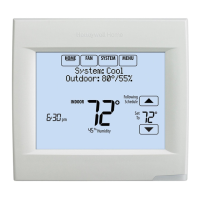
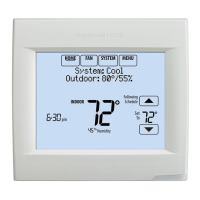
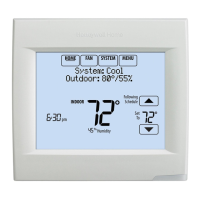
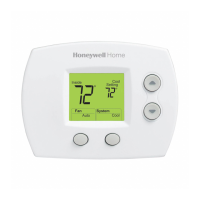
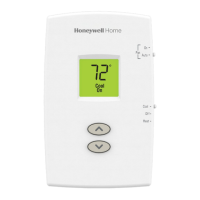
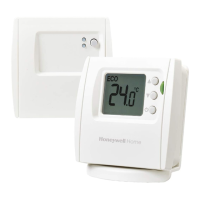
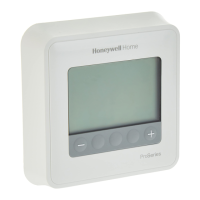
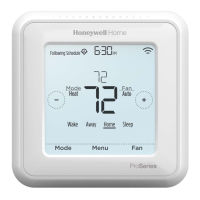
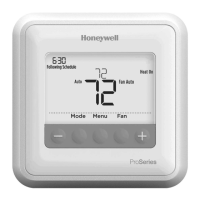
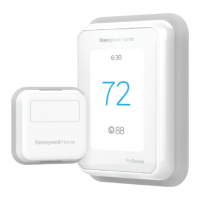
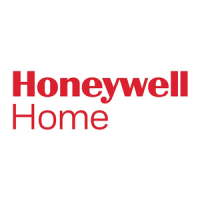

